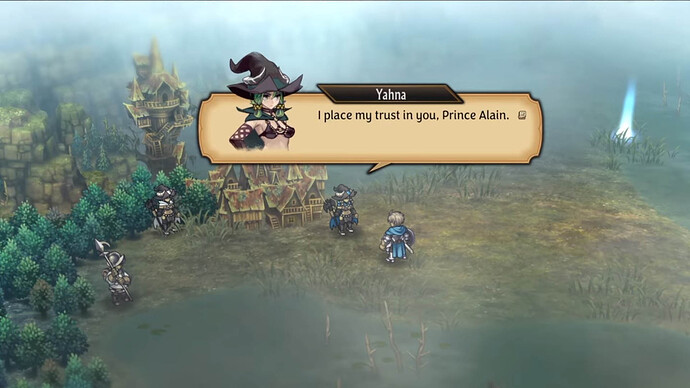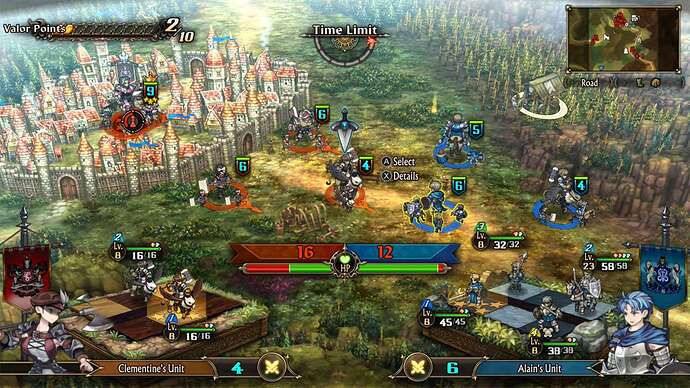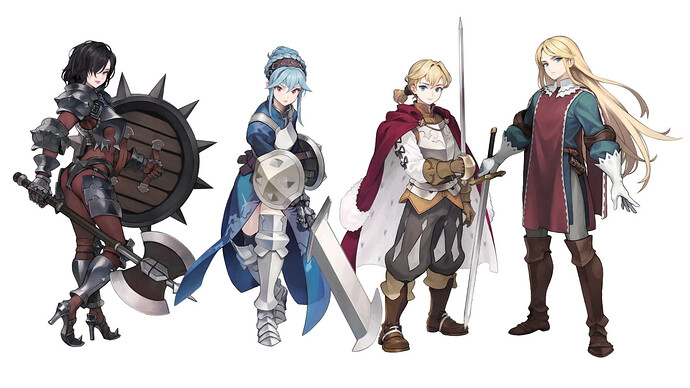Unicorn Overlord: A furry S&M dating sim? A cozy farming game set in thee Fae realms? No. It is neither of those. It is an Atlus strategy RPG that we should like.
And there are several things about it that I like, but it is also (so far) about as strategic as lawn darts. I’ll start with thee goode, kind sers. Well, actually, I’ll start with that–the dialogue is mostly terrible and very uneven. Some of it is overly regal and olden-dayes (and often unnaturally so) and some of it reads like it was spoken by a high schooler. Pick one or the other, and I’m on board, but both at random is jarring.
I know in these games, we often read/write that “the plot is standard fare,” and that has never been more true than for UO. And it’s easy to forgive that, especially if the gameplay is stellar (spoiler: it isn’t), but UO starts off with a plot we’ve seen many times before that is handled in a monumentally nonsensical way (“So the prince can escape, but his mom can’t? Or won’t? Because she’d rather die? Um, what?”) that reminds me of Star Wars: the Last Jedi (I was going to write “and not in a good way”, but is there a “good way” to be reminded of that movie?). Prince Alain then grows up and goes back to defeat the oppressors, drafting new allies along the way.
Gameplay is a jumble of things that are familiar but (for me, at least) are mixed together in a way that is new and periodically interesting. You have several small units of allies, at first just 2 allies per unit, then upgraded to 3, then 4, etc. thanks to the use of valor points that are earned mostly via battling. You deploy your units from an HQ at the beginning of a mission and move them around the map to take on units from the enemy boss for that mission. Below is the acceptance of a noble mission to Remove thee Olde Hammer Dude from thee City.
Once you accept the mission, the enemy boss disperses his units and the map changes to give you more detail of the battle areas. When your unit meets up with an enemy unit, they auto-battle in a JRPG-like setup. You don’t control anything during the battles, but you can do things before they begin to help your side, and the combinations of allies in each unit can be arranged to maximize effectiveness and create useful combinations.
I have just described the extent of the strategic elements in play here. That’s really it. There’s a lot of other stuff to do, but as far as the actual strategy, it’s finding the best allies to group together in units, and then moving the units (in real time, natch) to battle against the enemy units that they are best suited to clobber. You can even skip watching the battles if you want, which I often do because–I am not exaggerating–you are shown the outcome of any battle before you engage it. Not the odds or likelihood, but the outcome.
So if I decide to engage in the above battle, my unit will lose a total combined HP of 12, and the enemy unit will lose 16. If I don’t like that outcome, before I press “Aye, let us throwdown!”, I can use expendables to buff my unit (which at my age is normal–no judgement please) and improve the outcome. Other nearby allied units might also have a positive effect on the outcome.
Again, this is the extent of the strategy. It’s pretty lite for an rpg that costs $60 from Atlus. In some ways, if you can twist your brain enough to see this, the battles and unit movement sort of play out like Fire Emblem games. And also like FE, you build relationships between your troops if they stay in the same unit and do a lot of fighting together. I’m in the early game, so I have no idea if this evolves into romance.
Other things to know:
–Completing missions often leads to you having liberated cities and towns. You can then provide some found goods to these towns in the form of “deliveries” that level up the towns and allow you to do more things there. The towns also have shops you can resupply from.
–There is a fair bit of lady-character fan service (see below) which I personally have no issue with, but some might think the apparel is over the top at times. The group below is tame, actually.
–Saves are very easy and readily available, so you should never lose progress if you make a mistake. I don’t think there’s any real way to grind or need to, but I’m early into the game. You cannot change characters’ classes; when they advance a level, you do not get to choose which stats go up for them, it’s random (also like FE). Which I find very limiting. I have no sense of how long the game will be from playing it, but online reviews put it at 60 hours. So that works out to a dollar an hour for the price, which is not bad, actually. I don’t know how much replay value is here, as it seems pretty on-rails so far.
In all, I resent myself for continuing to play this game. The strategy bar is low, the plot is not exactly riveting, and the characters are mostly flat stereotypes. Playing the game on a harder difficulty level (there are 3) doesn’t really make the strategy more interesting, honestly, it just seems to add more enemy units with higher HPs. So it doesn’t make it trickier, it just makes the wall of obstacles thicker. For some people, that might be appealing, but for me, it is not.
The art is beautiful, though, and the gameplay seems to have been refined to walk that line between being casual and requiring enough thought to feel rewarding when you win. There is a strong sense of progression, both in terms of opening up more of the world to explore and in terms of increasing your roster and making more capable units. And so I keep playing this darn thing. There is a (long) demo, so you can easily try it yourself. Also, I genuinely have no idea why it is titled Unicorn Overlord.





